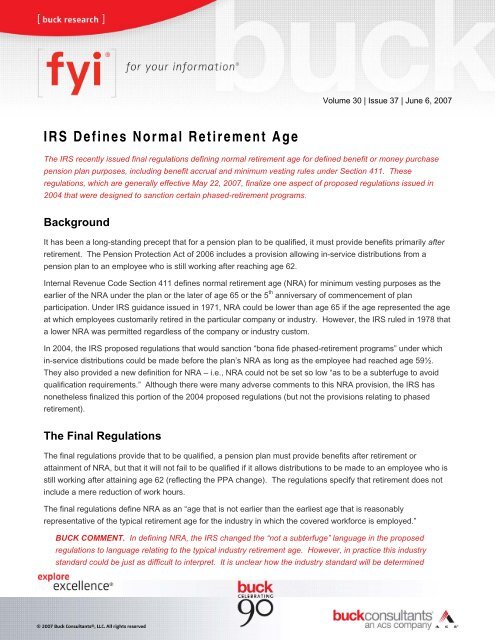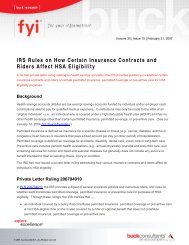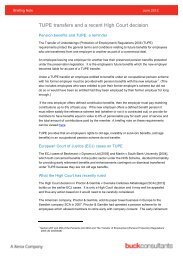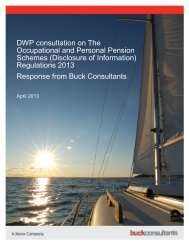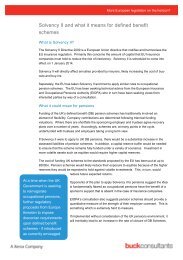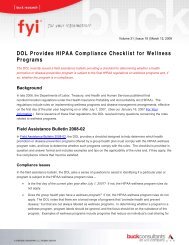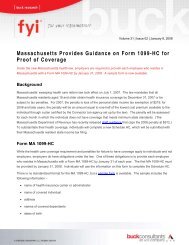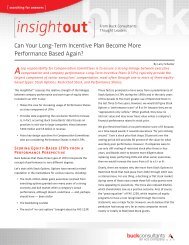IRS Defines Normal Retirement Age - Buckconsultants.com
IRS Defines Normal Retirement Age - Buckconsultants.com
IRS Defines Normal Retirement Age - Buckconsultants.com
You also want an ePaper? Increase the reach of your titles
YUMPU automatically turns print PDFs into web optimized ePapers that Google loves.
Volume 30 | Issue 37 | June 6, 2007<br />
<strong>IRS</strong> <strong>Defines</strong> <strong>Normal</strong> <strong>Retirement</strong> <strong>Age</strong><br />
The <strong>IRS</strong> recently issued final regulations defining normal retirement age for defined benefit or money purchase<br />
pension plan purposes, including benefit accrual and minimum vesting rules under Section 411. These<br />
regulations, which are generally effective May 22, 2007, finalize one aspect of proposed regulations issued in<br />
2004 that were designed to sanction certain phased-retirement programs.<br />
Background<br />
It has been a long-standing precept that for a pension plan to be qualified, it must provide benefits primarily after<br />
retirement. The Pension Protection Act of 2006 includes a provision allowing in-service distributions from a<br />
pension plan to an employee who is still working after reaching age 62.<br />
Internal Revenue Code Section 411 defines normal retirement age (NRA) for minimum vesting purposes as the<br />
earlier of the NRA under the plan or the later of age 65 or the 5 th anniversary of <strong>com</strong>mencement of plan<br />
participation. Under <strong>IRS</strong> guidance issued in 1971, NRA could be lower than age 65 if the age represented the age<br />
at which employees customarily retired in the particular <strong>com</strong>pany or industry. However, the <strong>IRS</strong> ruled in 1978 that<br />
a lower NRA was permitted regardless of the <strong>com</strong>pany or industry custom.<br />
In 2004, the <strong>IRS</strong> proposed regulations that would sanction “bona fide phased-retirement programs” under which<br />
in-service distributions could be made before the plan’s NRA as long as the employee had reached age 59½.<br />
They also provided a new definition for NRA – i.e., NRA could not be set so low “as to be a subterfuge to avoid<br />
qualification requirements.” Although there were many adverse <strong>com</strong>ments to this NRA provision, the <strong>IRS</strong> has<br />
nonetheless finalized this portion of the 2004 proposed regulations (but not the provisions relating to phased<br />
retirement).<br />
The Final Regulations<br />
The final regulations provide that to be qualified, a pension plan must provide benefits after retirement or<br />
attainment of NRA, but that it will not fail to be qualified if it allows distributions to be made to an employee who is<br />
still working after attaining age 62 (reflecting the PPA change). The regulations specify that retirement does not<br />
include a mere reduction of work hours.<br />
The final regulations define NRA as an “age that is not earlier than the earliest age that is reasonably<br />
representative of the typical retirement age for the industry in which the covered workforce is employed.”<br />
BUCK COMMENT. In defining NRA, the <strong>IRS</strong> changed the “not a subterfuge” language in the proposed<br />
regulations to language relating to the typical industry retirement age. However, in practice this industry<br />
standard could be just as difficult to interpret. It is unclear how the industry standard will be determined
Volume 30 | Issue 37 | June 6, 2007<br />
and what kind of proof employers will need to maintain to justify an age. It is interesting that this standard<br />
was adopted considering that the <strong>IRS</strong> eliminated it from its 1978 guidance.<br />
The regulations also provide specific guidelines for NRA as follows –<br />
• An NRA of age 62 is deemed to meet the above definition.<br />
• If an employer uses an NRA of age 55 to 62, the employer’s determination that it meets the industry<br />
standard will be given deference, as long as it is borne out by the facts and circumstances.<br />
• An NRA below age 55 is presumed not to be acceptable, but a case can be made to the <strong>IRS</strong> and a<br />
determination made that it meets the industry standard.<br />
• An NRA of age 50 for qualified public safety employees is deemed to meet the definition.<br />
BUCK COMMENT. Thus, if a plan’s NRA does not qualify under the above guidelines, it will be a<br />
disqualifying provision, which will need to be changed retroactively by the end of the plan’s remedial<br />
amendment period (e.g., by January 31, 2008 for Cycle B filers).<br />
Effective Dates<br />
The regulations are generally effective May 22, 2007, with later dates applying for governmental and collectively<br />
bargained plans.<br />
Transition Rule for Purposes of Section 411(d)(6)<br />
Compliance with the final regulations may require a plan to provide a later NRA than it currently provides, which<br />
would eliminate a participant’s right to an in-service distribution before reaching the revised NRA in violation of the<br />
Section 411(d)(6) anti-cutback rules. The regulations therefore amend current regulations under Section 411 to<br />
provide that such a plan amendment will not be a violation of Section 411(d)(6), but only for a plan amendment<br />
adopted after May 22, 2007 and on or before the last day of the applicable remedial amendment period.<br />
However, there is no relief with respect to other Section 411 rules.<br />
Conclusion<br />
Most plan sponsors will find that they are in <strong>com</strong>pliance with the new NRA standards. However, some plan<br />
sponsors, particularly those of certain cash balance and hybrid plans, will have to work quickly to redefine their<br />
NRA to avoid plan disqualification.<br />
Buck’s consultants are available to discuss your options under these new rules.<br />
This FYI is intended to provide general information. It does not offer legal advice or purport to treat all the issues surrounding<br />
any one topic.<br />
[ 2 ]


